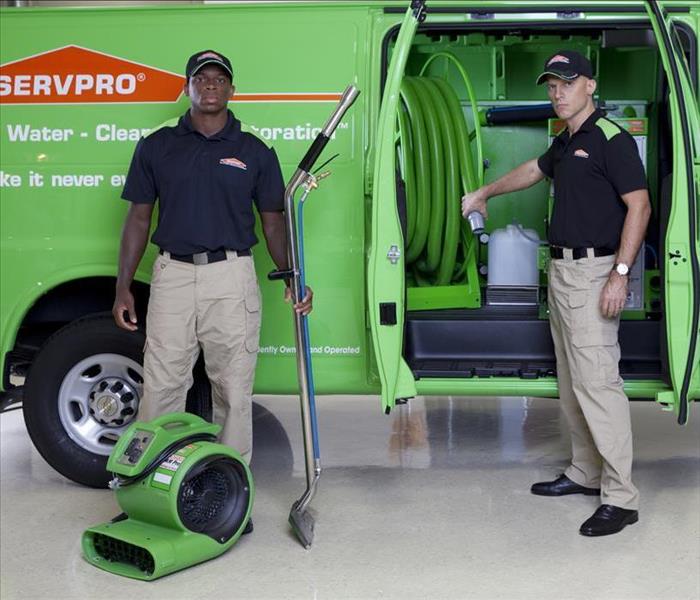Can Homeowners Count on Professional Flood Removal to Return Floors to Pre-Loss Condition?
9/23/2020 (Permalink)
 Our storm damage technicians have the equipment and experience to restore your home to pre-damage condition.
Our storm damage technicians have the equipment and experience to restore your home to pre-damage condition.
SERVPRO Selects from a Variety of Research-Based Solutions to Remove Flood Residues in Tallahassee, Bringing Residential Floors and Floor Covers Back to Function and Appearance.
It has been a robust hurricane season already this year, outstripping the names reserved, and the predictions in Tallahassee as elsewhere have changed more than once at the last minute. If your home has been in the path of an expected or last-minute storm, you can be knee deep in rainwater and overland flooding, along with mud, debris, and silt in a matter of minutes to hours.
How Does the Flooding Including Contaminants Affect Residential Flooring?
Each type of flooring in your Tallahassee residence needs flood removal of the standing water. Some of the materials used can sustain the onslaught of dirty water and grit fairly well. Other kinds of floods and floor coverings might need partial or total replacement. Working with a reputable flood damage mitigation and remediation company increases the odds of successful outcomes after the removal of the fluids and solids. Even if the news for some of the less durable or more vulnerable to irremediable damage structures of fixtures is not promising, knowing you are dealing with an honest and well-prepared company that helps with insurance claims softens the blow.
Where Do Professional Flood Removal Technicians Obtain Their Training?
SERVPRO enrolls managers and technicians in the Institute of Inspection, Cleaning, and Restoration Certification (IICRC) courses prior to hands-on flood removal work. The comprehensive catalog of training ground our workers in the fundamentals of water removal and recovery theory. Our crews learn about the best practices and standards that apply to potential floor damage after a flood.
Can Carpeting Hold Up to a Flooding Scenario?
Flood waters are defined as Category 3, or extremely contaminated fluids. The liquids that overland flooding push into your home are also called “black water,” extremely unsanitary and potentially carrying disease-causing organisms and chemical contaminants. Industry standards for carpets and their pads require that both layers must be removed and replaced. In rare cases, expensive area rugs damaged by Category 3 water can be:
- Cleaned
- Treated with a biocide
- Recleaned
- Dried
- Tested by an indoor environmental professional for confirmation that the rug reached a sanitary condition
How Durable Are Laminate Floors When Flooded?
New construction and rehabbing and remodeling projects often use engineered flooring, commonly known as laminates, to quickly and relatively inexpensively cover a subfloor. They are made of sandwiched layers of resin, foam, and heavy paper topped with a picture of the material the flooring mimics -- wood, stone, or tile -- protected with a transparent sheet. The multi-level material quickly absorbs water and warps. Water trapped below cannot evaporate because the layers act as a vapor barrier. Rapid delamination occurs, and the strips or sections cannot be restored and need replacement.
Do Hardwood Floors Win the Battle with Flood Waters?
Hardwood floors are highly prized and achieve a burnished patina over the years, evidencing their general durability. Fortunately, hardwood composition is dense, and it possesses natural water resistance. As long as the SERVPRO team arrives promptly, we can:
- Contain the affected area to prevent the spreading of airborne contaminants, including wrapping the room with 1.6 mil polyethylene and setting up air scrubbing technology
- Remove silt and debris with care to avoid scratching the wood surface
- Remove remaining standing water with wanded extractors
- Test for residual water percolating through the hardwood planks/strips
- Use floor mats and negative air pressure (suction) system to pull water from several layers of flooring
- Clean the floor with EPA-registered proprietary products
- Disinfect with EPA-registered antimicrobials
- Dry with a balanced system of air movement, warmer temperatures, and dehumidifiers
Note: If the hardwood warps because the fluids were absorbed into the unfinished bottom and sides of the planks/strips causing cupping, the distortion often can be sanded out once the wood returns to normal moisture levels.
Are Tile Floors Survivors After Flood Damage Removal?
Resilient Tiles
Vinyl and asphalt tiles are the two primary types, normally glued down to a concrete subfloor. Asphalt tiles usually make it through flooding, debris, and water removal intact. If a few come loose, they are simple to reattach or replace. Vinyl tiles are more likely to disengage due to glue failure. As the tiles can deteriorate, SERVPRO might discuss replacing them with new materials during claim discussions with your insurance.
Ceramic Tiles
Properly set, grouted, and sealed ceramic tiles can be nearly waterproof. If the force of the flooding dislodges them, the flood water can penetrate into the subfloor. On occasion, the grout between the tiles can develop cracks before the flood, providing egress for the floodwaters into the substrate. Similarly, if the floor edges have dried out or cracked caulking, the flood water can seep through. If the tiles are sound, or you have extras, the SERVPRO can:
- Use portable extractors or floor mats to pull water out of the subfloor
- Use air movers, heaters, and dehumidifiers to evaporate the residual moisture
- Arrange to reset and regrout the floor, sealing the porous grout lines to establish its waterproof character
The professionals at SERVPRO of Central Tallahassee are adept at flood removal protocols that ensure you and your loved ones have clean, dry, and beautiful floors to support daily tasks and fun. We’re Faster To Any Size Disaster, and invite calls for flooding recovery 24/7 at (850) 765-5706.






 24/7 Emergency Service
24/7 Emergency Service